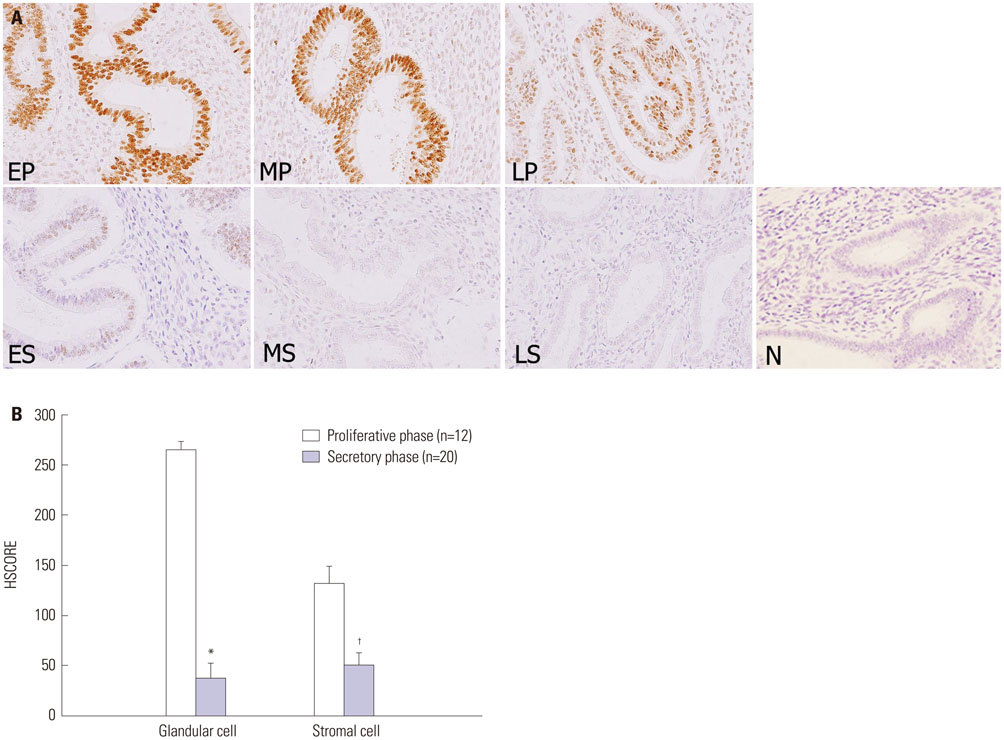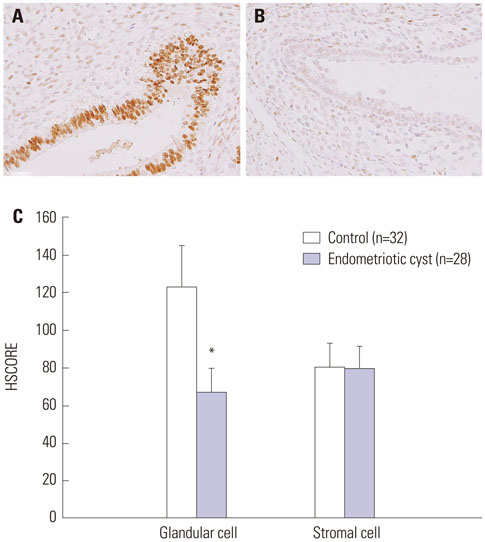Yonsei Med J.
2016 Nov;57(6):1468-1474. 10.3349/ymj.2016.57.6.1468.
Decreased Progesterone Receptor B/A Ratio in Endometrial Cells by Tumor Necrosis Factor-Alpha and Peritoneal Fluid from Patients with Endometriosis
- Affiliations
-
- 1Department of Obstetrics and Gynecology, University of Ulsan College of Medicine, Asan Medical Center, Seoul, Korea. kimsung@amc.seoul.kr
- KMID: 2427166
- DOI: http://doi.org/10.3349/ymj.2016.57.6.1468
Abstract
- PURPOSE
Progesterone resistance is thought to be a major factor that contributes to progression of endometriosis. However, it is not clear what causes progesterone resistance in endometriosis. This study aimed to assess whether cytokines or peritoneal fluid can affect progesterone receptor (PR) expression in endometrial cells and to verify whether PR expression is reduced in endometriosis.
MATERIALS AND METHODS
The PR-B/A ratio was measured via real-time polymerase chain reaction after in vitro culture, in which endometrial cells were treated with either tumor necrosis factor-alpha (TNF-α), interleukin-1 beta, or peritoneal fluid obtained from women with advanced-stage endometriosis. Immunohistochemistry was performed to compare PR-B expression between eutopic and ectopic endometrial tissues from women with and without advanced-stage endometriosis.
RESULTS
The PR-B/A ratio was significantly decreased by treatment with either TNF-α (p=0.011) or peritoneal fluid from women with advanced-stage endometriosis (p=0.027). Immunoreactivity of PR-B expression was significantly lower during the secretory phase than during the proliferative phase in endometrial tissues from control subjects (p<0.001). PR-B expression was significantly reduced in the eutopic endometrium (p=0.031) and ovarian endometrioma (p=0.036) from women with advanced-stage endometriosis compared with eutopic endometrium tissues from control subjects.
CONCLUSION
Progesterone resistance in endometriosis may be caused by proinflammatory conditions in the pelvic peritoneal microenvironment.
MeSH Terms
-
Adult
Ascitic Fluid/*metabolism
Case-Control Studies
Cytokines/*metabolism
Endometriosis/genetics/*metabolism/pathology/physiopathology
Endometrium/abnormalities/*metabolism/pathology
Female
Gene Expression
Humans
Immunohistochemistry
Real-Time Polymerase Chain Reaction
Receptors, Progesterone/*metabolism
Tumor Necrosis Factor-alpha/*metabolism
Uterine Diseases
Cytokines
Receptors, Progesterone
Tumor Necrosis Factor-alpha
Figure
Cited by 1 articles
-
Women with Endometriosis, Especially Those Who Conceived with Assisted Reproductive Technology, Have Increased Risk of Placenta Previa: Meta-analyses
Hyeji Jeon, Jiwon Min, Deok Kyeong Kim, Heekyung Seo, Sunkyung Kim, Yun-Sook Kim
J Korean Med Sci. 2018;33(34):. doi: 10.3346/jkms.2018.33.e234.
Reference
-
1. Eskenazi B, Warner ML. Epidemiology of endometriosis. Obstet Gynecol Clin North Am. 1997; 24:235–258.
Article2. Giudice LC, Kao LC. Endometriosis. Lancet. 2004; 364:1789–1799.
Article3. Kim SH, Chae HD, Kim CH, Kang BM. Update on the treatment of endometriosis. Clin Exp Reprod Med. 2013; 40:55–59.
Article4. Eisermann J, Gast MJ, Pineda J, Odem RR, Collins JL. Tumor necrosis factor in peritoneal fluid of women undergoing laparoscopic surgery. Fertil Steril. 1988; 50:573–579.
Article5. Hill JA, Anderson DJ. Lymphocyte activity in the presence of peritoneal fluid from fertile women and infertile women with and without endometriosis. Am J Obstet Gynecol. 1989; 161:861–864.
Article6. Fakih H, Baggett B, Holtz G, Tsang KY, Lee JC, Williamson HO. Interleukin-1: a possible role in the infertility associated with endometriosis. Fertil Steril. 1987; 47:213–217.
Article7. Mori H, Sawairi M, Nakagawa M, Itoh N, Wada K, Tamaya T. Peritoneal fluid interleukin-1 beta and tumor necrosis factor in patients with benign gynecologic disease. Am J Reprod Immunol. 1991; 26:62–67.
Article8. Chen DB, Yang ZM, Hilsenrath R, Le SP, Harper MJ. Stimulation of prostaglandin (PG) F2 alpha and PGE2 release by tumour necrosis factor-alpha and interleukin-1 alpha in cultured human luteal phase endometrial cells. Hum Reprod. 1995; 10:2773–2780.
Article9. Osteen KG, Bruner-Tran KL, Eisenberg E. Reduced progesterone action during endometrial maturation: a potential risk factor for the development of endometriosis. Fertil Steril. 2005; 83:529–537.
Article10. Kao LC, Germeyer A, Tulac S, Lobo S, Yang JP, Taylor RN, et al. Expression profiling of endometrium from women with endometriosis reveals candidate genes for disease-based implantation failure and infertility. Endocrinology. 2003; 144:2870–2881.
Article11. Bulun SE, Cheng YH, Yin P, Imir G, Utsunomiya H, Attar E, et al. Progesterone resistance in endometriosis: link to failure to metabolize estradiol. Mol Cell Endocrinol. 2006; 248:94–103.
Article12. Revised American Society for Reproductive Medicine classification of endometriosis: 1996. Fertil Steril. 1997; 67:817–821.13. Noyes RW, Hertig AT, Rock J. Dating the endometrial biopsy. Am J Obstet Gynecol. 1975; 122:262–263.
Article14. Kim SH, Lee HW, Kim YH, Koo YH, Chae HD, Kim CH, et al. Down-regulation of p21-activated kinase 1 by progestin and its increased expression in the eutopic endometrium of women with endometriosis. Hum Reprod. 2009; 24:1133–1141.
Article15. Lee MY, Kim SH, Ihm HJ, Chae HD, Kim CH, Kang BM. Up-regulation of p21-activated kinase 1 by in vitro treatment with interleukin 1-beta and its increased expression in ovarian endometriotic cysts. Fertil Steril. 2011; 96:508–511.
Article16. Kim SH, Kim SR, Ihm HJ, Oh YS, Chae HD, Kim CH, et al. Regulation of P21-activated kinase-4 by progesterone and tumor necrosis factor-α in human endometrium and its increased expression in advanced-stage endometriosis. J Clin Endocrinol Metab. 2013; 98:E238–E248.
Article17. Lee II, Kim JJ. Influence of AKT on progesterone action in endometrial diseases. Biol Reprod. 2014; 91:63.
Article18. Attia GR, Zeitoun K, Edwards D, Johns A, Carr BR, Bulun SE. Progesterone receptor isoform A but not B is expressed in endometriosis. J Clin Endocrinol Metab. 2000; 85:2897–2902.
Article19. Lessey BA, Metzger DA, Haney AF, McCarty KS Jr. Immunohistochemical analysis of estrogen and progesterone receptors in endometriosis: comparison with normal endometrium during the menstrual cycle and the effect of medical therapy. Fertil Steril. 1989; 51:409–415.
Article20. Misao R, Iwagaki S, Fujimoto J, Sun W, Tamaya T. Dominant expression of progesterone receptor form B mRNA in ovarian endometriosis. Horm Res. 1999; 52:30–34.
Article21. Hayashi A, Tanabe A, Kawabe S, Hayashi M, Yuguchi H, Yamashita Y, et al. Dienogest increases the progesterone receptor isoform B/A ratio in patients with ovarian endometriosis. J Ovarian Res. 2012; 5:31.
Article
- Full Text Links
- Actions
-
Cited
- CITED
-
- Close
- Share
- Similar articles
-
- A Study of Altered IL-6 and TNF-alpha Expression in Peritoneal Fluid of Patients with Endometriosis
- Effects of Insulin-like Growth Factor in Peritoneal Fluid of Patients with Endometriosis on the Proliferation of Endometrial Stromal Cells
- TNF-alpha concentration of plasma and peritoneal fluid in women with endometriosis: Dose TNF-alpha influence the pathogenesis of endometriosis
- A study of Cytokine in Peritoneal Fluid of Infertile Patients with Endometriosis
- A Study of Altered Cell-Mediated Immunity in Peritoneal Fluid of Patients with Endometriosis





